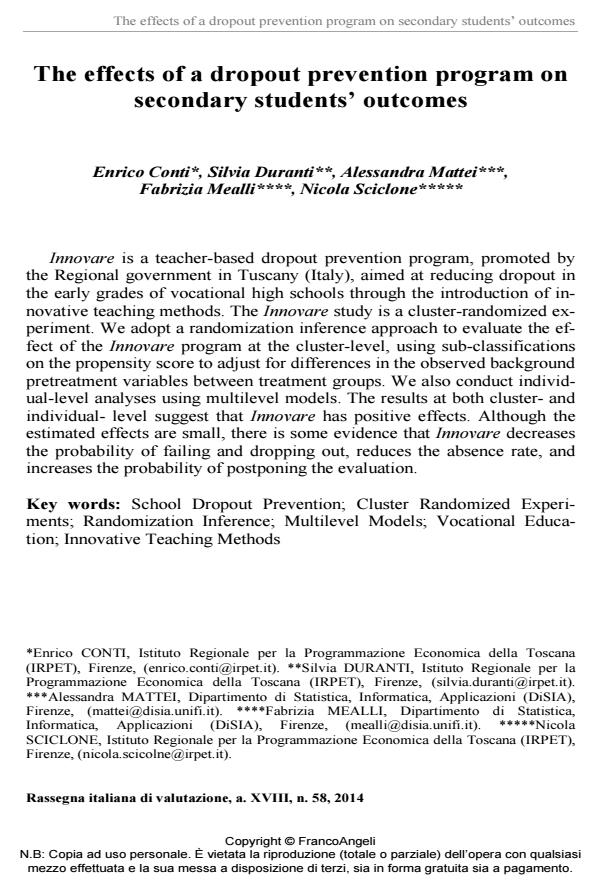The effects of a dropout prevention program on secondary students’ outcomes
Titolo Rivista RIV Rassegna Italiana di Valutazione
Autori/Curatori Enrico Conti, Silvia Duranti, Alessandra Mattei, Fabrizia Mealli, Nicola Sciclone
Anno di pubblicazione 2015 Fascicolo 2014/58 Lingua Inglese
Numero pagine 35 P. 15-49 Dimensione file 368 KB
DOI 10.3280/RIV2014-058003
Il DOI è il codice a barre della proprietà intellettuale: per saperne di più
clicca qui
Qui sotto puoi vedere in anteprima la prima pagina di questo articolo.
Se questo articolo ti interessa, lo puoi acquistare (e scaricare in formato pdf) seguendo le facili indicazioni per acquistare il download credit. Acquista Download Credits per scaricare questo Articolo in formato PDF

FrancoAngeli è membro della Publishers International Linking Association, Inc (PILA)associazione indipendente e non profit per facilitare (attraverso i servizi tecnologici implementati da CrossRef.org) l’accesso degli studiosi ai contenuti digitali nelle pubblicazioni professionali e scientifiche
Innovare is a teacher-based dropout prevention program, promoted by the Regional government in Tuscany (Italy), aimed at reducing dropout in the early grades of vocational high schools through the introduction of innovative teaching methods. The Innovare study is a cluster-randomized experiment. We adopt a randomization inference approach to evaluate the effect of the Innovare program at the cluster-level, using sub-classifications on the propensity score to adjust for differences in the observed background pretreatment variables between treatment groups. We also conduct individual- level analyses using multilevel models. The results at both cluster- and individual- level suggest that Innovare has positive effects. Although the estimated effects are small, there is some evidence that Innovare decreases the probability of failing and dropping out, reduces the absence rate, and increases the probability of postponing the evaluation.
Keywords:School Dropout Prevention; Cluster Randomized Experiments; Randomization Inference; Multilevel Models; Vocational Education; Innovative Teaching Methods
- Mealli F., Pacini B. and Rubin D.B. (2011). Statistical inference for causal effects. In: Kenett R.
- Blum R.W. and Ellen J. (2002). Work group V: Increasing the capacity of schools, neighborhoods, and communities to improve adolescent health outcomes. Journal of Adolescent Health, 31: 288-292. DOI: 10.1016/S1054-139X(02)00490-1
- Braun T.M. and Feng Z. (2001). Optimal permutation tests for the analysis of group randomized trials. Journal of the American Statistical Association, 96: 1424-1432. DOI: 10.1198/016214501753382336
- de Leeuw J. and Meijer E. (2008). Handbook of Multilevel Analysis, Springer, New York.
- Donner A. (1998). Some aspects of the design and analysis of cluster randomized trials. Journal of the Royal Statistical Society: Series C (Applied Statistics), 47: 95-113. DOI: 10.1111/1467-9876.00100
- Duncan C., Jones K. and Moon G. (1998). Context, composition and heterogeneity: Using multilevel models in health research. Social Science & Medicine, 46: 96-117. DOI: 10.1016/S0277-9536(97)00148-2.ChoH.,HallforsD.D.andSanchezV.(2005).Evaluationofahighschoolpeergroupinterventionforat-riskyouth.JournalofAbnormalChildPsychology,33:363-374.DOI
- 10.1007/s10802-005-3574-4.
- Fisher R.A. (1925). Statistical methods for research workers. Oliver and Boyd, Edinburgh, First edition.
- Frangakis C.E., Rubin D.B. and Zhou X.H. (2002). Clustered encouragement designs with individual level noncompliance. Biostatistics, 3: 147-177. DOI: 10.1093/biostatistics/3.2.14
- Goldstein H. (2003). Multilevel statistical models, 3rd edn. Arnold, London.
- Imbens, G.W. and Wooldridge J.M. (2009). Recent developments in the econometrics of program evaluation. Journal of Economic Literature, 47: 5-86. DOI: 10.1257/jel.47.1.
- Italian Ministry of Education (2013). Gli alunni stranieri nel sistema scolastico italiano a.s. 2012/2013. MIMEO.
- Kemmis S. and McTaggart R. (1982). Action research in education. Deakin University Press.
- and Salini S. (Eds.) Modern Analysis of Customer Satisfaction Surveys. Wiley, 173-192.
- Murray D. (1998) Design and analysis of group randomized trials. New York: Oxford University Press.
- Murray D., Hannan P.J., Pals S.P., McCowen R.G., Baker W.L. and Blitstein J.L. (2006). A comparison of permutation and mixed-model regression methods for the analysis of simulated data in the context of a group-randomized trial. Statistics in Medicine, 25: 375-388. DOI: 10.1002/sim.2233
- Regional Institute for the Economic Planning of Tuscany (2014a). Rapporto sulla dispersion scolastica in Toscana (In Italian). MIMEO.
- Regional Institute for the Economic Planning of Tuscany (2014b). The evaluation of the Innovare program in Tuscany (In Italian). MIMEO
- Rosembaum P.R. and Rubin D.B. (1983). The central role of the propensity score in observational studies for causal effects. Biometrika, 70: 41-55. DOI: 10.2307/2335942
- Rubin D.B. (1974). Estimating causal effects of treatments in randomized and nonrandomized studies. Journal of Educational Psychology, 66: 688-701.
- Rubin, D.B. (1978). Bayesian inference for causal effects: the role of randomization. The Annals of Statistics, 6: 34-58. DOI: 10.1214/aos/1176344064
- Rubin, D.B. (1990a). Comment: Neyman (1923) and causal inference in experiments and observational studies. Statistical Science, 5: 472-480. DOI: 10.1214/ss/1177012032
- Rubin D.B. (1990b). Formal modes of statistical inference for causal effects. Journal of Statistical Planning and Inference, 25, 279-292. DOI: 10.1016/0378-3758(90)90077-8
- Rubin D.B. (2005). Causal inference using potential outcomes: Design, modeling, decisions. Journal of the American Statistical Association, 100: 322-331. DOI: 10.1198/016214504000001880
- Small D.S., Ten-Have T.R. and Rosenbaum P.R. (2008). Randomization inference in a group-randomized trial of treatments for depression: Covariate adjustment, noncompliance, and quantile effects. Journal of the American Statistical Association, 103: 271-279. DOI: 10.1198/01621450700000089
Enrico Conti, Silvia Duranti, Alessandra Mattei, Fabrizia Mealli, Nicola Sciclone, The effects of a dropout prevention program on secondary students’ outcomes in "RIV Rassegna Italiana di Valutazione" 58/2014, pp 15-49, DOI: 10.3280/RIV2014-058003